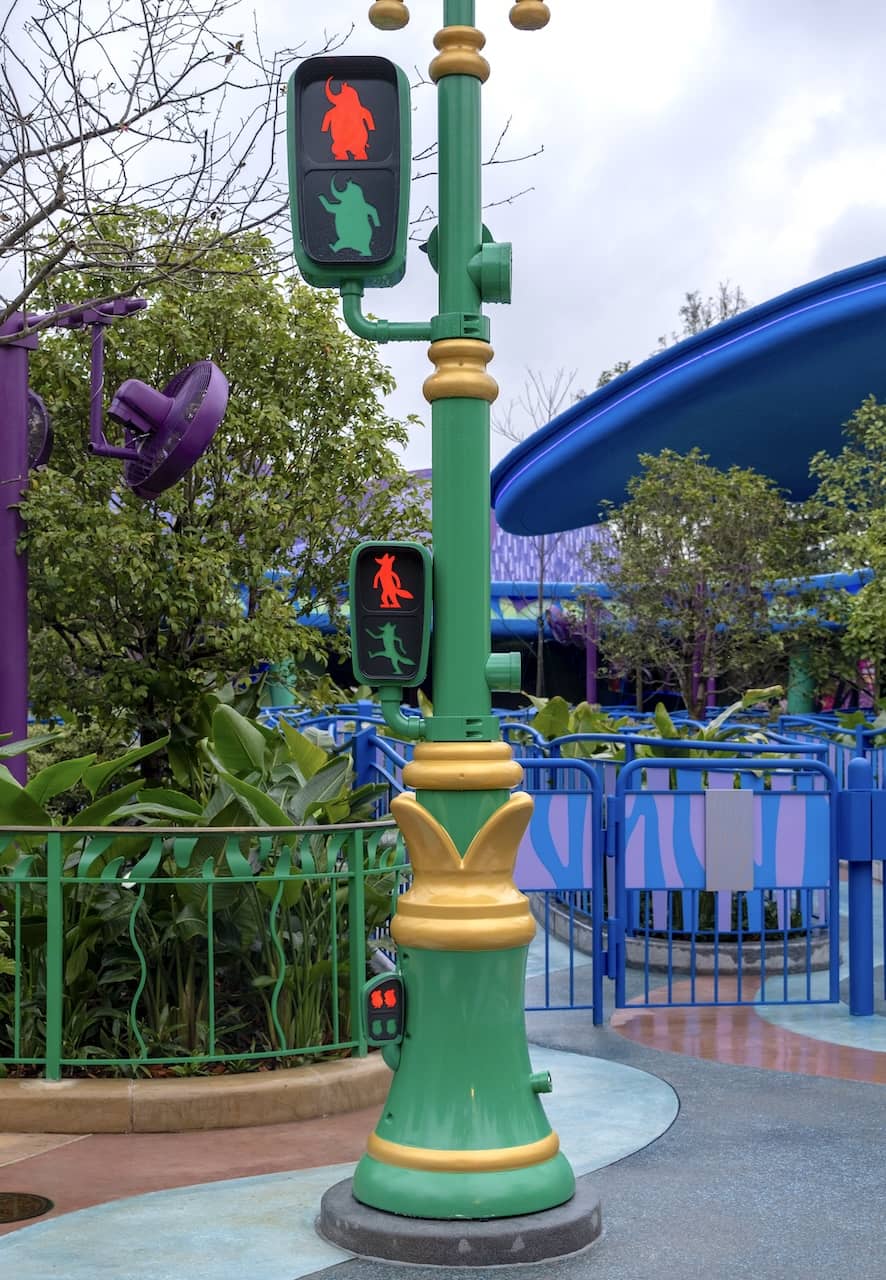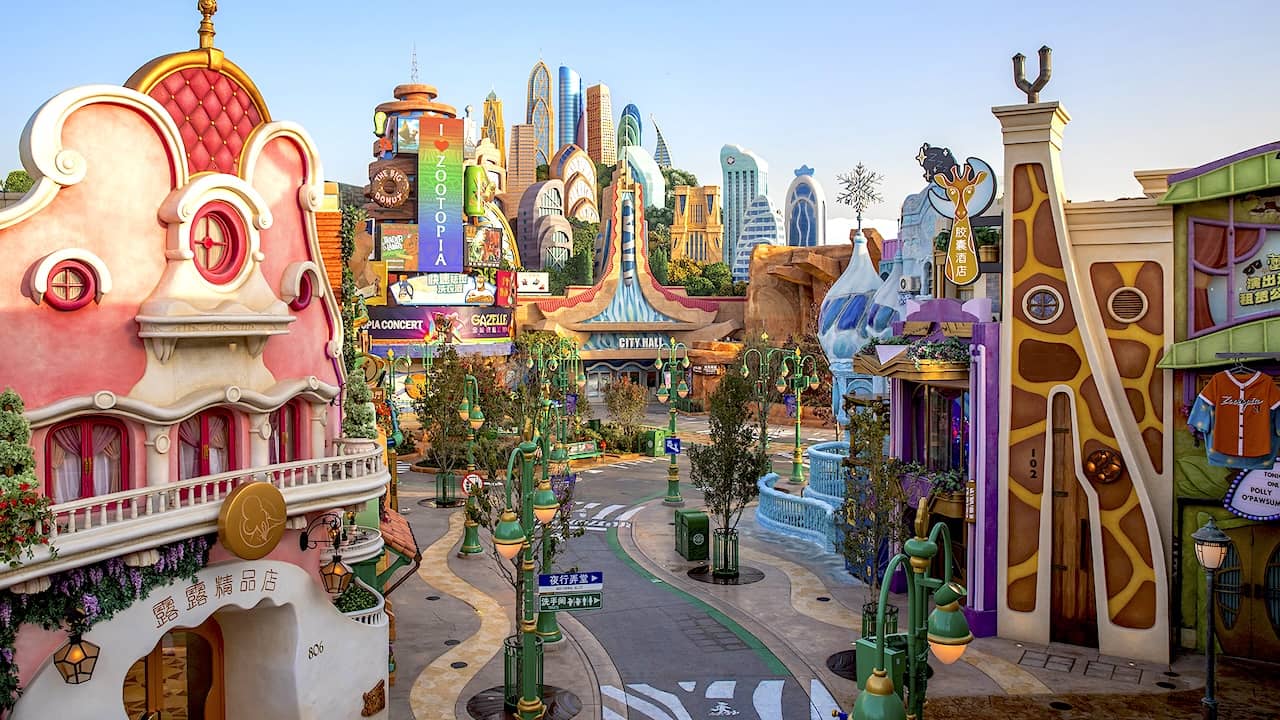Modern theme park design is rooted in narrative, and Shanghai Disneyland's new Zootopia land is no exception, moving forward after the events of the original film to further develop the world of Nick and Judy. During the park's press event last week, I had the opportunity to tour of the land with Walt Disney Imagineering Creative Director Dustin Schofield, who led the design of new land.
Not unlike the Summer Snow Day at Hong Kong Disneyland's World of Frozen, you won't be visiting Zootopia on just any normal day. Today is Zootopia Day!
Schofield explains, "It's the big day of the year where predator and prey celebrate living together in harmony, and the ambassador to that unified Zootopia celebration is Gazelle, who is of course doing the big Zootopia Day concert tonight."
This underlying story is reinforced simply by wandering the area. Large advertisements for tonight's concert adorn lamp posts and posters, while a Times Square-esque Jumbotron regularly features the ungulate diva dancing across screen to hype the masses. It seems everyone in Zootopia is talking about tonight's concert.

The land features many activation points, Easter eggs, and other visual gags that contribute to building excitement for Gazelle's show. Characters such as Fru Fru, Yax, or Koslov can be heard behind certain doors or walls, often chatting about their excitement for tonight's show.
"And then, Clawhauser brings that story home when you go inside the E-ticket [the Zootopia: Hot Pursuit ride] because no one's more excited about the Gazelle concert tonight than him," Schofield said.
The buildup for the concert sets the stage for the main plot of Zootopia: Hot Pursuit, which you can read more about here.
While Zootopia in the film has a diverse set of districts to cater to various habitat preferences, such as Tundra Town, Sahara Square, and the Rainforest District, the land itself is the downtown melting pot of all these areas. You're at the heart of Zootopia here, and it's not designed for human beings but for all mammals.
"There's this big [design] concept to Zootopia that we call hyper-diversity, where we see animals from this really diverse, rich place and by sort of accommodating and adapting to one another they appear stronger as a society," says Schofield.
"It's this really great message that creates that same sense of excitement and optimism that Judy Hopps had when she first arrived in the city of Zootopia."
The optimism portrayed in Judy's arrival seen is the exactly the energy the land seeks to capture, as it was one of the scenes that resonated strongly with Chinese audience during market research.
That "hyper-diversity" is seen at every turn: crosswalk lights come with buttons at mouse, wolf, and rhino heights, the local gym's treadmill functions for both giraffe and gerbil workouts, and the Zootopia Transit Authority incorporates pneumatic tubes for rodents as part of their transportation lines, branching from the main train station.

Schofield references one of the nearby facades: "This is a barbershop for sheep, but the things that's unique about is that after they've shorn the wool, they vacuum it up, send it through a dyeing and a spooling machine that turns it into thread for the wool and linen store next door." The attached clothing shop displays the knitted products for sale, including fox sweaters and giraffe leg warmers.

He continues, "Even the restrooms are adapted for animals of all sizes. The human scale doors are within the elephant scale doors. We've got the small door down below for the mice, the elevated door for the climbing animals, and the upside down one for the bats…. In fact, we've actually Zootopified a lot of our traditional theme park fixtures. Even our drinking fountains and our benches are accommodating animals of all sizes. One of our most popular photo ops is large elephant sized bench. I love that bench so much because it's really fun to play with scale in the world of Zootopia."
The driving design ethos behind Shanghai Disneyland is the oft-repeated phrase "authentically Disney, distinctly Chinese," and that remained a key component of the process behind Zootopia.
"It's always good to take people from the known to the unknown and everybody's been to a city before," Schofield further explains. "We didn't want Zootopia to be grounded in a city from the United States as an example. It really needed to feel like it was recognizable to our guests from Shanghai and other parts of China. So, the cityscape is very much influenced by things you would see in a Chinese city… Even some of the businesses we selected, like KTVs are super popular here - people love karaoke, so we did a Gazelle-branded KTV as one of our businesses on the street."
This guiding principle is felt in the eclectic, organized chaos of the land, especially when packed with other guests. The psychedelic skyline lighting up at night would be another component familiar to Chinese guests, not so different from downtown Shanghai a few kilometers away, or indeed any one of dozens of Chinese urban centers. It also informed making certain that the endless punchlines landed in both languages.

"We worked with a lot of local artisans as well that are from Shanghai. So there's always a sounding board through the process, like, hey, do you guys get this joke? Is this funny? Does this feel relevant?"
As someone familiar with China, I would feel remiss to not point out my own observations on the elements of Zootopia that I think resonate here, but perhaps would fall flat elsewhere. (So, from here on out, opinions are entirely my own and are completely unrelated to my interview with Dustin.) It's undeniable that the aforementioned design choices make the land "distinctly Chinese" in a myriad of very clever ways, but I think there is a deeper set of thematic narratives that attract the local audience.
While the film Zootopia did well with Western audiences, I think for most people a lot of the primary thematic lessons centered around discrimination and racism (or in this case, "specism.") While I don't think this message was lost on Chinese audience, the central takeaway was different.
Zootopia is a story about a rural bunny, an underdog with big dreams, who makes her way to the big city in an idealized society where everyone lives in peace. When she arrives, she finds the reality isn't what she expected, but through hard work and perseverance she achieves her goals, truly demonstrating that Zootopia is a place where "anyone can be anything."
In other words, Zootopia is a meritocracy where hard work is rewarded with success, residents control their impulses in order to contribute to the greater good, and despite societal flaws, the patriotic collective believes in prioritizing interpersonal harmony over individual well-being. That the central plot is one where the police are heroes taking down government corruption is icing on the cake.
These are ideas that are relatable and desirable to a Chinese market, in both a cultural and political sense. China's rapid urbanization makes Judy's story familiar to literally hundreds of millions of people, safety and security are principles highly regarded in Chinese society, and President Xi's signature policy upon coming into power was centered on rooting out corruption at all levels of government.
Furthermore, the enthusiasm for Zootopia in China is difficult to understate, and for many here, it is "the" quintessential Disney film. "Try Everything," a largely forgettable tune to most Americans, is a staple earworm for Chinese youth. Disney's theme parks always have been masters at monetizing nostalgia, but Chinese audiences don't hold the same fondness for what many in the West would consider "the classics." With Zootopia (the land) now opening seven years after the movie, just as the children of 2016 start to age into being consumers themselves, Disney is leveraging some of its strongest cultural capital in the country.
Imagineering's decision-making in the design of Zootopia has been intentional and detail-oriented, creating a unique land that misses no opportunities to crack a joke or further the lore of the Zootopia "universe" while still adapting smoothly to diverse cultural and political sensitivities. It makes for a welcome addition to Shanghai Disneyland, rounding out a roster of attractions short on dark rides while complementing some of the most unique and spacious lands in a castle park.
For Theme Park Insider's complete coverage of the opening of Zootopia at Shanghai Disneyland, please see the following posts:
For tickets to the park, please visit our partner's Shanghai Disneyland tickets page.
* * *
To keep up to date with more theme park news, please sign up for Theme Park Insider's weekly newsletter.
I second that--great read!
Joining the crowd to say this (along with your other pieces) have been phenomenal. Thanks for sharing.
This article has been archived and is no longer accepting comments.
Great coverage and context. Thanks for this!